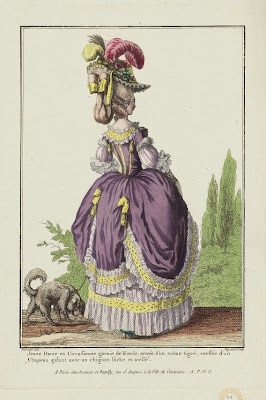 |
| Tassel in silk and metal, 1600-1700, Western Europe, V&A, Londra Nappa in seta e metallo, 1600-1700, Europa Occidentale,V&A, Londra |
Generally when we think of tassels, little tufts of ratty thread hanging from the key to the china cabinet or the curtains of your grandmother's house come to mind; fussy little objects which are always an addition to something else rather than an artform in themselves, yet if we dig a little into the past we find that tassels have a long and fascinating history and are not by any means banal.
Solitamente quando uno pensa alle nappe viene in mente un'immagine di oggettini frusti che pendono dalla chiave della vetrinetta delle porcellane o che decorano le tende alla casa della nonna; troppo elaborati e sempre una addizione eccessiva invece di un'arte a sé, però se scaviamo un poco nel passato troviamo che le nappe hanno una storia lunga, affascinante e non per niente scontata.
The art of tassel making has been around for thousands of years. In the Bible (Numbers 15:38-40) the faithful are urged to decorate their garments with blue tassels to remind them of the Lord's commandments and in the Middle and Far East there is a long tradition of using tassels to ward off evil. They are also found all around the globe from China to Egypt to Perù in an extraordinary variety of forms and techniques.
L’arte delle nappe è molto antica. Nella Bibbia (Numeri 15:38-40) i fedeli sono pregati di decorare i loro vestiti con delle piccole nappe blu per ricordarsi dei comandamenti del Signore e nel Medio ed Estremo Oriente esiste una lunga tradizione del uso delle nappe contro gli spiriti maligni. Si trovano in tutto il mondo, dalla Cina all’Egitto al Perù in una varietà straordinaria di tecniche e forme.
 |
| Peruvian Tassel, British Museum, London Nappa peruviana, British Museum, Londra |
 |
| Chinese silk tassel, 600-800 AD, V&A, London Nappa cinese in seta, 600-800 AD, V&A, Londra |
In Europe they became an important part of male costume in the second quarter of the 17th century, the fanciful white linen constructions being a sign of wealth and status and can be seen in many male portraits of the time, particularly in Northern Europe.
In Europa diventarono parte importante del costume maschile nel secondo quarto del ‘600, queste costruzioni fantasiose di lino bianco furono simbolo di stato e benessere e si vedono in tanti ritratti dell’epoca, in particolare in Nord Europa.
 |
| Frans Hals, Portrait of a man, 1650-1652 |
 |
| 17th century linen tassel Nappa seicentesca in lino |
During the 17th and 18th centuries the manufacture of polychrome silk and metal tassels also developed into a complex craft in Europe being used to decorate bags and other accessories, gowns and furnishings. These Baroque and Rococo tassels were produced throughout Western Europe and most particularly in France where a large-scale passamentry industry was established.
Durante il 17˚ e 18˚ secoli la manifattura di nappe di sete policrome e metallo diventò un mestiere complesso in Europa e si usarono per decorare le borse e altri accessori, vestiti e anche nell’arredamento. Queste nappe Barocche e Rococo si produssero in tutta l’Europa Occidentale e in particolare in Francia, dove ci fu una grande industria di passamanerie.
 |
| Bag, England, early 17th century, Metropolitan Museum of Art, New York Borsetta, Inghilterra, primi '600, Metropolitan Museum of Art, New York |
May 2012 will be devoted to tassels at Textile Support; we will have an exhibition of contemporary pieces by artists as well as courses and seminars on the subject. I will keep you posted as the date gets closer. In the mean time I will close with some images of the beautiful polychrome tassels made by textile and costume historian Thessy Schoenholzer Nichols on display in our gallery.
Maggio 2012 sarà dedicato alle nappe a Textile Support; avremo una mostra di nappe contemporanee creati d’artisti vari assieme a dei seminari e corsi sul tema. Vi terrò aggiornati mentre l’evento si avvicina. Nel frattempo chiudo con alcuni immagini delle bellissime nappine policrome della storica del tessuto e del costume Thessy Schoenholzer Nichols attualmente esposte nella nostra galleria.
 |
| By/di: Thessy Schoenholzer Nichols |
 |
| By/di: Thessy Schoenholzer Nichols |
 |
| By/di: Thessy Schoenholzer Nichols |


Molto interessante, direi proprio affascinante la storia delle disprezzate nappine!
ReplyDeleteNaturalmente puoi contare sulla mia presenza.
Thanks for provide the latest and largest breaking news about textile engineering and technology. you are such an amazing author.
ReplyDelete